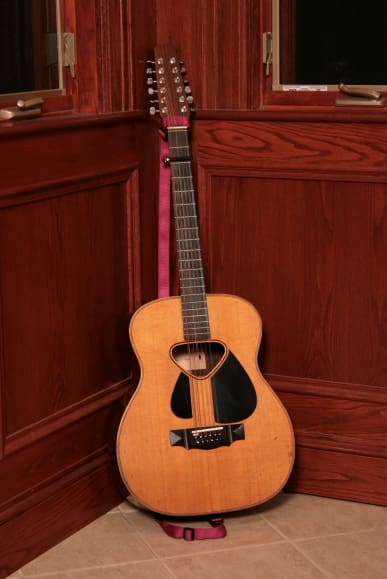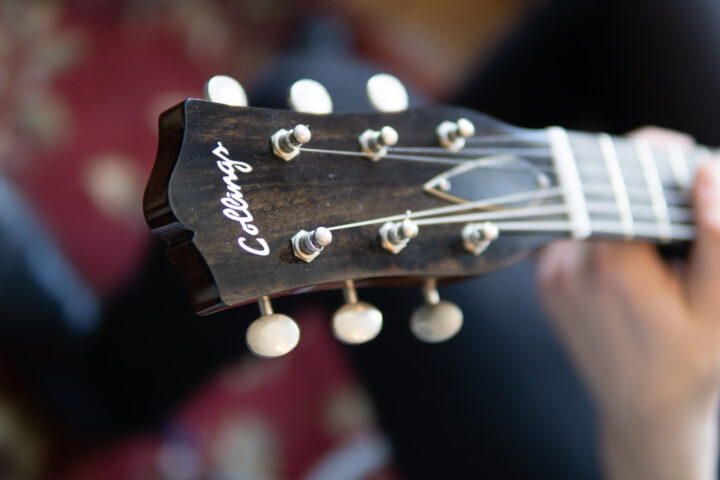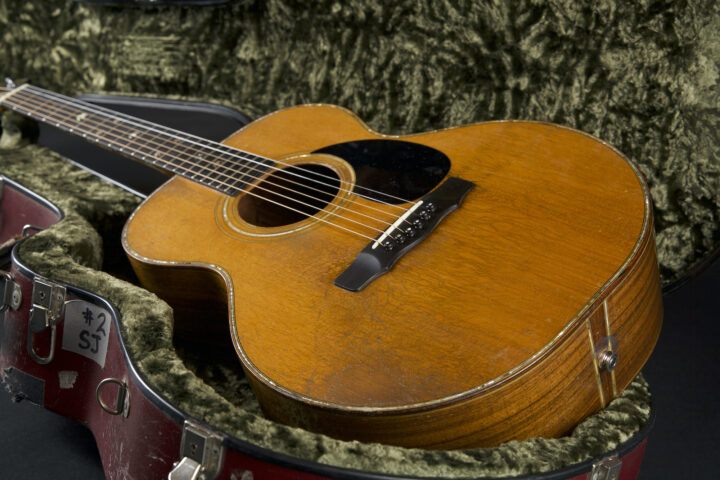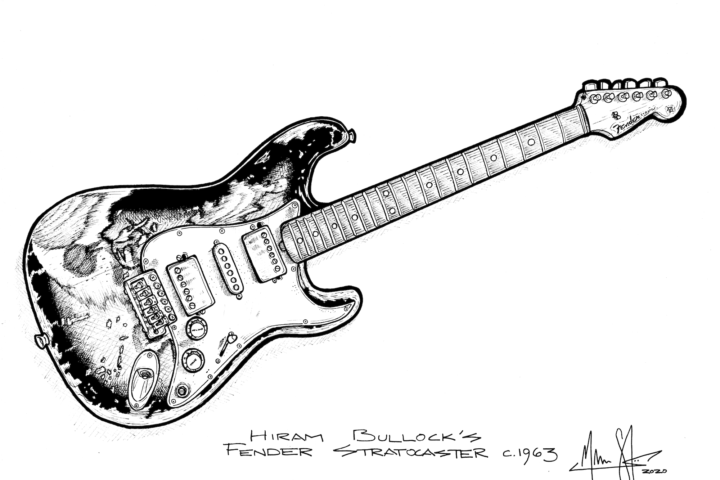
With its similarly epic 27.75″ scale and distinctive triangular soundhole, Pete Seeger’s 12-string guitar is nearly as iconic as his banjo. The original 12-string was created by Liverpool engineer Stanley Francis within a few years of Seeger making his banjo. Seeger met Francis–who also made instruments for Lonnie Donegan and BBC folk stars Robin Hall and Jimmie MacGregor–on a brief English tour with Ramblin’ Jack Elliott in 1959, and he was fascinated by the amateur luthier’s ideas about guitar construction.
“He’d worked out this slightly different way of bracing it inside,” Seeger says. “After all, there’s a lot of pressure in there. He had these diagonal braces, so he had a triangular hole. He made one for a friend, and I saw it and I said, ‘That’s got a beautiful tone.’”
Francis and Seeger talked, and the result was one battleship of a guitar–strung with long, loud, heavy courses–that was custom made to support the song leading that increasingly appealed to Seeger.
“He was just a curious amateur and he had great success, especially when people wanted to have a 12-string guitar tuned low the way Leadbelly tuned his guitar low.”
But Seeger treats his instruments as tools, not treasures, and soon enough, the first Francis guitar folded up under Seeger’s–and the strings’–constant pressure. So did a second one. Therefore, Connecticut luthier Bruce A. Taylor (no relation to California guitar magnate Bob Taylor) has actually been making copies of the Francis guitar for Seeger since 1973.
Back in 1973, when Taylor first met Seeger at the Clearwater Festival, he was stunned by the legendary musician’s trust and generosity; Seeger saw that Taylor was genuinely interested in the construction of his guitar, so he simply left the Francis 12-string with the budding luthier while he took the stage with his banjo.
Taylor sheepishly admits that Seeger can be tough on his stuff. One early Taylor-constructed instrument met its fate at the foot of an angry Republican.
“I had a lot of lefty slogans all over my guitar case,” Seeger says, “and somewhere between Los Angeles and New York, some person said, ‘I’ll fix these goddamn lefties,’ and he opened the guitar case and punched his foot right through the top of the guitar and then closed the case. I didn’t open it up when I first got it from the airport, but 24 hours later, I opened it up and I could see his heel print right where he had stamped it through. It was too late to complain to American Airlines.”
Another helpless victim was left leaning against Seeger’s car after a gig. When he pulled forward, it fell to the ground; when he backed up, it was crushed. What could Taylor do? He made him another.
“I’ve been very careful not to lean that one against the car,” Seeger says. “I also don’t have so many signs on my guitar case.”
Over the years, Taylor, through experimentation, has actually made a number of changes and improvements to the original Francis design–including the addition of a transverse brace that intersects the two parts of Francis’ original X bracing, so that the bridge sits in its own triangle. “He had two other long braces,” Taylor says, “that more or less came up from the heel block and intersected the X brace near the edge of the bridge.”
Other changes include the use of rosewood bridge plates (in place of Francis’ unusual, narrow, laminated original) and the standard array of 12 string holes (in place of Francis’ arrangement of a half-dozen). Taylor also employs a streamlined peghead. Tone comes from Sitka spruce on top (splattered here and there with dabs of Seeger’s red paint) and East Indian rosewood on the back and sides. Most of the rest of Taylor’s work comes down to keeping the instrument together under such enormous strain.
All of Taylor’s 12-strings–which are also played by Tom Chapin and John McCutcheon, among others–are strung with custom La Bella sets designed by Seeger and the guitar maker during a series of visits to the E. & O. Mari plant in Newburgh, New York. To compensate for the huge strings, including a .070 double-wound low C, Taylor has placed a small auxiliary saddle (which has, not surprisingly, cracked a bit) just behind the primary bone saddle in the ebony bridge.
“Pete’s tuned four half-steps below concert pitch,” Taylor says, “and the string scale [from zero fret to saddle] is just short of 28 inches. I guess he got his original inspiration from Leadbelly, who played a shorter scale but had heavy strings on his–tuned slack, too.”
While a few of Taylor’s customers have asked for adjustable truss rods (which the Francis featured), he prefers not to go that route, noting that “the headstock is under enough strain up there without being weakened by having a hole in it.” Instead, he lays a pre-stressed, rectangular, graphite-composite truss rod into a slot in the mahogany neck before adding an ebony fingerboard. The neck-to-body assembly is mortise and tenon. “It’s not made to come apart,” Taylor says–even if Seeger has tried to prove him wrong more than once.
Seeger generally plays “the 12-stringer,” as he calls it, with thumb and finger picks, hence Taylor’s distinctive double pickguard. “I like a white one,” Seeger says, in reference to his thumb pick, “so I can find it when I drop it.” He favors a drop-D tuning he learned from Bahamian legend Joseph Spence, leaving the instrument, more often than not, tuned to Bb F Bb Eb G C.
“I knew that Leadbelly had two or three different tunings for his guitar,” Seeger says, “but I didn’t get into other tunings until I watched this great guitar player in Nassau in the Bahamas. I went down to visit him, and he played for about an hour for me, and everything was in drop-D tuning, and I got into drop-D tuning, too.”
To access all the odd keys he sings in–whatever suits a singing crowd best–Seeger has become a wiz with a Shubb capo. In older photos with the Francis guitar, it’s not unusual to see a small block of wood jammed into the chrome handle of a Hamilton capo–just to keep things in place and in tune. It is no surprise, then, that the locking mechanism on the chrome-plated Shubb currently in his 12-string Blue Heron bag is bent at an odd angle–from all the years of work holding down those burly bridge cables he calls strings. – Michael Eck


